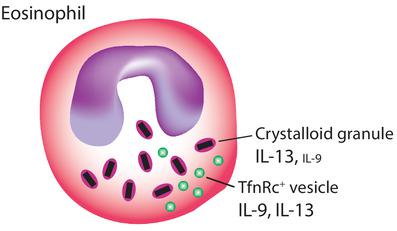当前位置:
X-MOL 学术
›
J. Leukoc. Biol.
›
论文详情
Our official English website, www.x-mol.net, welcomes your
feedback! (Note: you will need to create a separate account there.)
Cytokine trafficking of IL‐9 and IL‐13 through TfnRc+ vesicles in activated human eosinophils
Journal of Leukocyte Biology ( IF 3.6 ) Pub Date : 2020-09-10 , DOI: 10.1002/jlb.2ma0820-320rr Sarah Almas 1 , Nawell Fayad 1 , Ojas Srivastava 1 , Mujtaba Siddique 1 , Nicolas Touret 2 , Paige Lacy 1
Journal of Leukocyte Biology ( IF 3.6 ) Pub Date : 2020-09-10 , DOI: 10.1002/jlb.2ma0820-320rr Sarah Almas 1 , Nawell Fayad 1 , Ojas Srivastava 1 , Mujtaba Siddique 1 , Nicolas Touret 2 , Paige Lacy 1
Affiliation

|
Eosinophils are granulocytes that are elevated in lung mucosa in approximately half of patients with allergic asthma. These highly granulated cells can synthesize and secrete many cytokines, including IL‐9 and IL‐13. We hypothesized that IL‐9 and IL‐13 are found as preformed mediators in crystalloid granules and secreted using distinct trafficking pathways. Human eosinophils were purified from peripheral venous blood, adhered to coverslips, and stimulated with platelet activating factor (PAF). Cells were immunolabeled with antibodies to IL‐9 or IL‐13 and colocalized with markers for secretory organelles, using CD63 for crystalloid granules and transferrin receptor (TfnRc) for vesicles. Fixed cells were imaged using super‐resolution microscopy and quantified by colocalization using Pearson's correlation coefficient. IL‐9 immunofluorescence increased in a time‐dependent manner to PAF, whereas colocalization of IL‐9 and CD63 significantly increased from 0.52 to 0.67 after 5 min PAF. Colocalization of IL‐9 with TfnRc significantly increased at 60 min of stimulation with PAF (0.54 at 0 min to 0.60 at 60 min). IL‐13 showed lower colocalization with CD63 (0.55) than TfnRc (0.63) in unstimulated cells. Upon PAF stimulation, IL‐13 intensity transiently decreased at 5 and 60 min, whereas colocalization of IL‐13 with CD63 decreased throughout stimulation to 0.43. While colocalization of IL‐13 with TfnRc transiently increased to 0.66 at 5 min PAF, it returned to near baseline levels (0.64) after 15 min PAF. Our results suggest that IL‐9 and IL‐13 are stored in crystalloid granules as well as endosomal structures, and that IL‐9 is primarily trafficked to the cell surface via TfnRc+ endosome‐like vesicles.
中文翻译:

在活化的人嗜酸性粒细胞中通过TfnRc +囊泡进行IL-9和IL-13的细胞因子运输
嗜酸性粒细胞是大约一半过敏性哮喘患者肺粘膜中升高的粒细胞。这些高度颗粒化的细胞可以合成并分泌许多细胞因子,包括IL-9和IL-13。我们假设IL-9和IL-13被发现是晶体颗粒中的预制介质,并通过不同的运输途径分泌。从外周静脉血中纯化人嗜酸性粒细胞,粘附在盖玻片上,并用血小板活化因子(PAF)刺激。使用针对IL-9或IL-13的抗体对细胞进行免疫标记,并针对分泌性细胞器使用标记物共定位,对于晶体颗粒使用CD63,对于囊泡使用转铁蛋白受体(TfnRc)。使用超高分辨率显微镜对固定细胞进行成像,并使用Pearson相关系数通过共定位进行定量。IL-9免疫荧光以时间依赖性的方式增加至PAF,而PAF 5分钟后,IL-9和CD63的共定位从0.52显着增加至0.67。在用PAF刺激60分钟时,IL-9与TfnRc的共定位显着增加(0分钟时为0.54,60分钟时为0.60)。在未刺激的细胞中,IL-13与CD63(0.55)的共定位性低于TfnRc(0.63)。PAF刺激后,IL-13强度在5和60分钟时短暂降低,而IL-13与CD63的共定位在整个刺激过程中降低至0.43。虽然IL-13与TfnRc的共定位在5分钟PAF时瞬时增加到0.66,但在15分钟PAF之后又回到接近基线水平(0.64)。我们的结果表明,IL-9和IL-13均以晶体颗粒和内体结构形式存储,+内体样小泡。
更新日期:2020-09-10
中文翻译:

在活化的人嗜酸性粒细胞中通过TfnRc +囊泡进行IL-9和IL-13的细胞因子运输
嗜酸性粒细胞是大约一半过敏性哮喘患者肺粘膜中升高的粒细胞。这些高度颗粒化的细胞可以合成并分泌许多细胞因子,包括IL-9和IL-13。我们假设IL-9和IL-13被发现是晶体颗粒中的预制介质,并通过不同的运输途径分泌。从外周静脉血中纯化人嗜酸性粒细胞,粘附在盖玻片上,并用血小板活化因子(PAF)刺激。使用针对IL-9或IL-13的抗体对细胞进行免疫标记,并针对分泌性细胞器使用标记物共定位,对于晶体颗粒使用CD63,对于囊泡使用转铁蛋白受体(TfnRc)。使用超高分辨率显微镜对固定细胞进行成像,并使用Pearson相关系数通过共定位进行定量。IL-9免疫荧光以时间依赖性的方式增加至PAF,而PAF 5分钟后,IL-9和CD63的共定位从0.52显着增加至0.67。在用PAF刺激60分钟时,IL-9与TfnRc的共定位显着增加(0分钟时为0.54,60分钟时为0.60)。在未刺激的细胞中,IL-13与CD63(0.55)的共定位性低于TfnRc(0.63)。PAF刺激后,IL-13强度在5和60分钟时短暂降低,而IL-13与CD63的共定位在整个刺激过程中降低至0.43。虽然IL-13与TfnRc的共定位在5分钟PAF时瞬时增加到0.66,但在15分钟PAF之后又回到接近基线水平(0.64)。我们的结果表明,IL-9和IL-13均以晶体颗粒和内体结构形式存储,+内体样小泡。











































 京公网安备 11010802027423号
京公网安备 11010802027423号